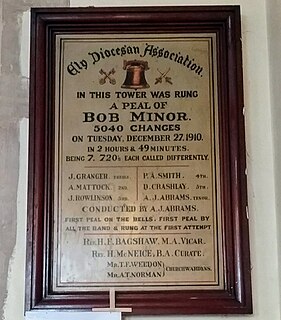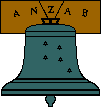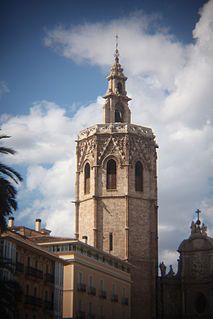
Change ringing is the art of ringing a set of tuned bells in a tightly controlled manner to produce precise variations in their successive striking sequences, known as "changes". This can be by method ringing in which the ringers commit to memory the rules for generating each change, or by call changes, where the ringers are instructed how to generate each change by instructions from a conductor. This creates a form of bell music which cannot be discerned as a conventional melody, but is a series of mathematical sequences.
Campanology is the scientific and musical study of bells. It encompasses the technology of bells – how they are founded, tuned, and rung – as well as the history, methods, and traditions of bellringing as an art.
A handbell is a bell designed to be rung by hand. To ring a handbell, a ringer grasps the bell by its slightly flexible handle – traditionally made of leather, but often now made of plastic – and moves the arm to make the hinged clapper strike the inside of the bell. An individual handbell can be used simply as a signal to catch people's attention or summon them together, but handbells are also often heard in tuned sets.
Method ringing is a form of change ringing in which the ringers commit to memory the rules for generating each change of sequence, and pairs of bells are affected. This creates a form of bell music which is continually changing, but which cannot be discerned as a conventional melody. It is a way of sounding continually changing mathematical permutations.

Russian Orthodox bell ringing has a history starting from the baptism of Rus in 988 and plays an important role in the traditions of the Russian Orthodox Church.
The Oxford University Society of Change Ringers, founded in 1872, is the official society dedicated to change ringing in Oxford University. Its objects are to promote the art of change ringing in the University and to ring for Sunday services in Oxford during full term.

A "ring of bells" is the name bell ringers give to a set of bells hung for English full circle ringing. The term "peal of bells" is often used, though peal also refers to a change ringing performance of more than about 5,000 changes.

The Nottingham University Society of Change Ringers (NUSCR) is one of the oldest societies affiliated to the University of Nottingham Students' Union, being founded in 1958. Its principal aim is to allow students from both the University of Nottingham and Nottingham Trent University to practise English Change Ringing. It also represents the University at the annual Northern Universities Association (NUA) Striking Competition each November.
The Ancient Society of College Youths (ASCY) is a change ringing society, founded in 1637 and based in the City of London. The society played a leading role in the early development of change ringing, and today provides ringers for important events at St Paul's Cathedral and Westminster Abbey. Although it is a non-territorial association, its importance is recognised through having four representatives on the Central Council of Church Bell Ringers.

In campanology, a peal is the special name given to a specific type of performance of change ringing which meets certain exacting conditions for duration, complexity and quality.
Grandsire is one of the standard change ringing methods, which are methods of ringing church bells or handbells using a series of mathematical permutations rather than using a melody. The grandsire method is usually rung on an odd number of bells: Grandsire doubles is rung on five working bells, grandsire triples on seven, grandsire caters on nine and grandsire cinques on eleven. Like all odd-bell methods, where there are sufficient bells, it is normally rung with a "cover" bell, which stays in the last position in each row to add musicality.
The North American Guild of Change Ringers (NAGCR) was founded in 1972 after the hanging of a ring of bells in the Washington National Cathedral in Washington, D.C., United States, in 1964. The NAGCR has now grown and expanded to 52 bell towers across the United States and Canada as well as one mini-ring and 9 hand-bell groups with more than 500 members residing in North America. This organization performs the art of change ringing or method ringing, a form of campanology, in the towers and on hand-bells. This art uses mathematical sequences and patterns to change bell orders to carry out these sequences. Change ringing began in England in the 17th century.
Fabian Stedman (1640–1713) was an English author and a leading figure in the early history of campanology, particularly in the field of method ringing. He had a key role in publishing two books Tintinnalogia and Campanalogia which are the first two publications on the subject. He is also regarded as being a pioneer in the branch of mathematics known as Group theory.
The Bolognese bellringing system took shape during the Middle Ages, and was perfected in the 19th century. It is a form of full circle ringing.

Cretingham is a village and a civil parish in the East Suffolk district, in the English county of Suffolk. It is on the River Deben, 2 miles south off the A1120 road. It is four miles west from Framlingham and eight miles northwest from Woodbridge.

Full circle ringing is a method of ringing a tower bell such that it swings in a complete circle from mouth upwards to mouth upwards and then back again repetitively.
The Central Council of Church Bell Ringers (CCCBR) is an organisation founded in 1891 which represents ringers of church bells in the English style.

The Australian and New Zealand Association of Bellringers, known as ANZAB, is the organisation responsible for the promotion of English-style "full circle ringing" – namely change ringing and method ringing in bell towers with a peal of bells – across Australia and New Zealand.

The Duke's Tower, also known as Inveraray Bell Tower, is the detached bell tower of All Saints' Church, Inveraray, Argyll and Bute, Scotland. Standing 126 feet high on the shores of Loch Fyne, it is a landmark for miles and amongst the most notable bell towers in the United Kingdom. The tower was built as a memorial to members of the Clan Campbell who died in the First World War. It is Grade A listed by Historic Environment Scotland, the highest possible rating.

The Miguelete Tower is the bell tower of the Valencia Cathedral in Valencia, Spain. It is known as El Miguelete in Castilian Spanish or Torre del Micalet in the Valencian language. Construction of the tower began in 1381 and was completed in 1429. Due to its complexity and long years of construction, it was successively directed by several master builders; the first being Andrés Juliá, from 1381. Others were José Franch (1396), Pedro Balaguer ; to Martín Llobet (1425), the last of the architects to work on the construction. Subsequently, the belfry was added (1660-1736).










